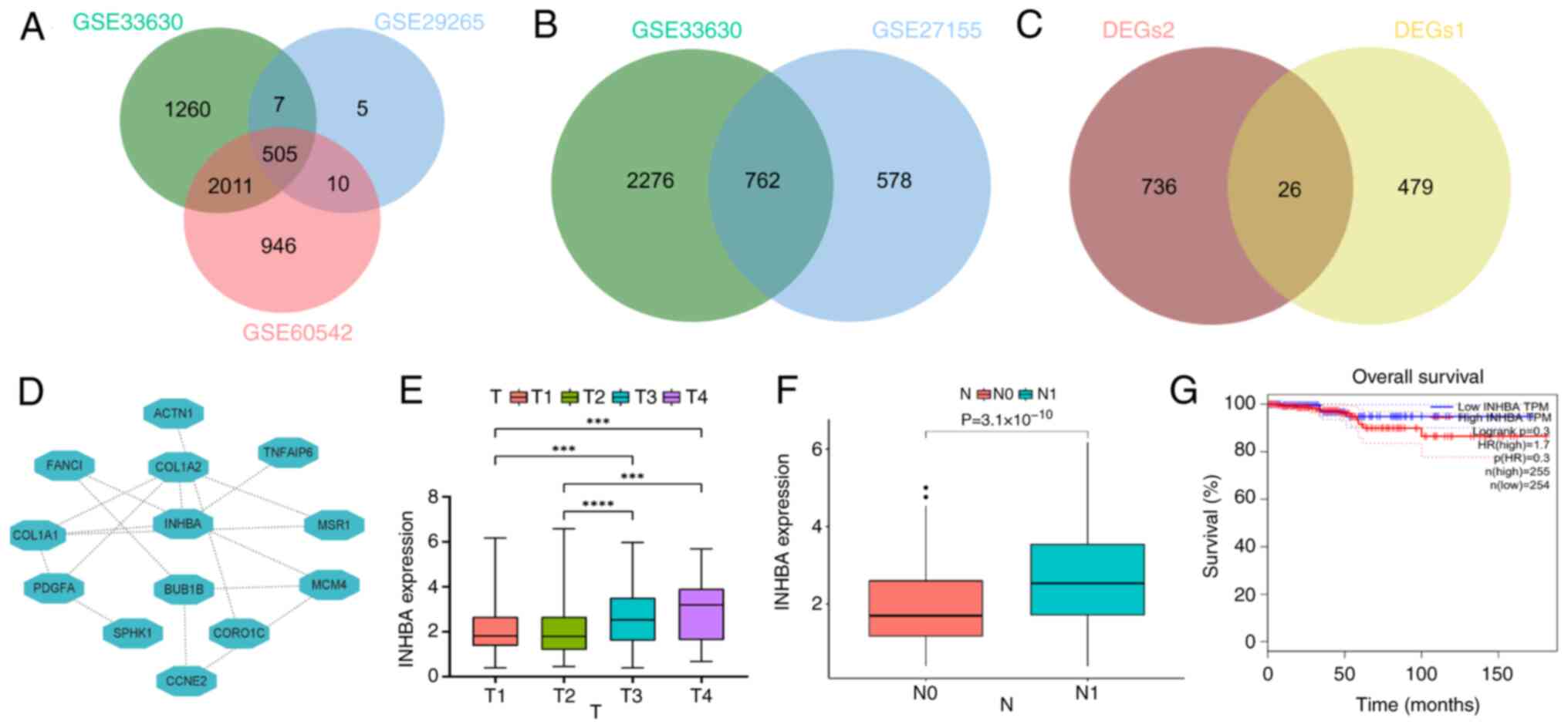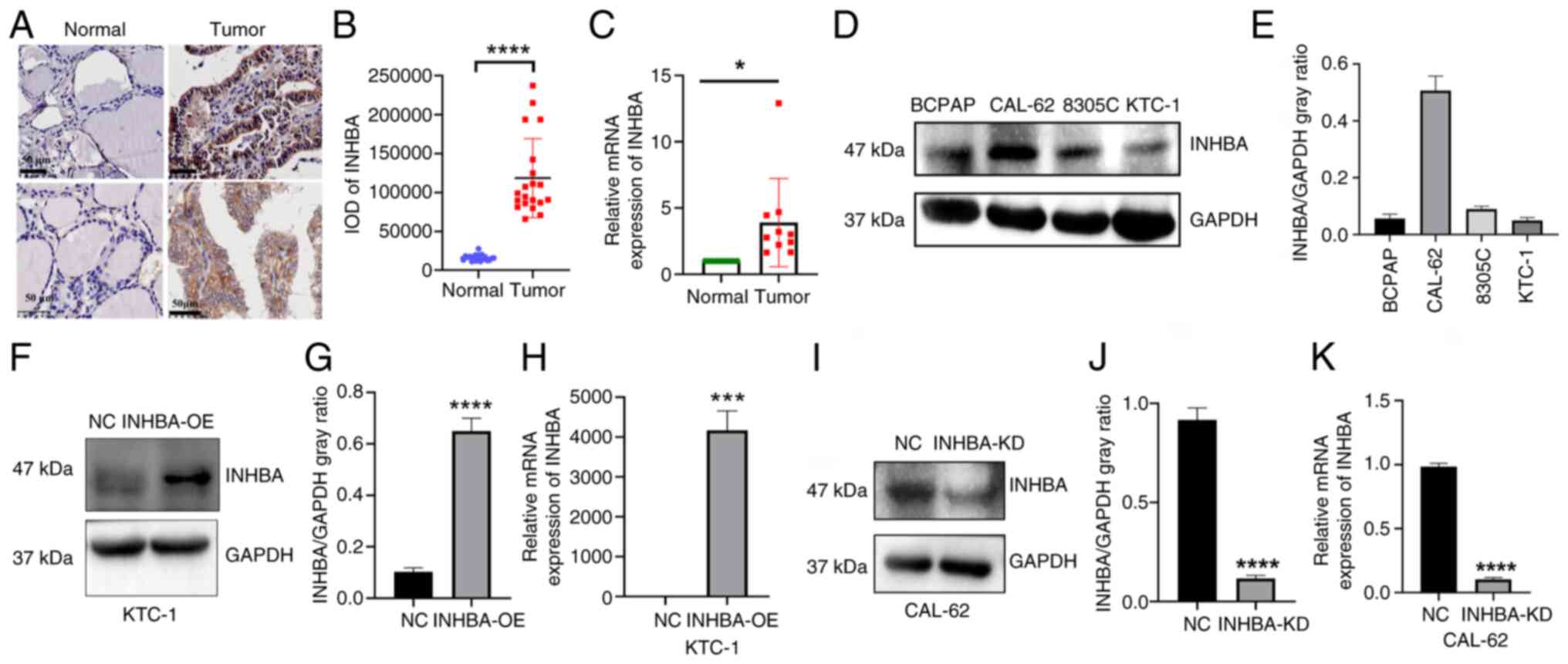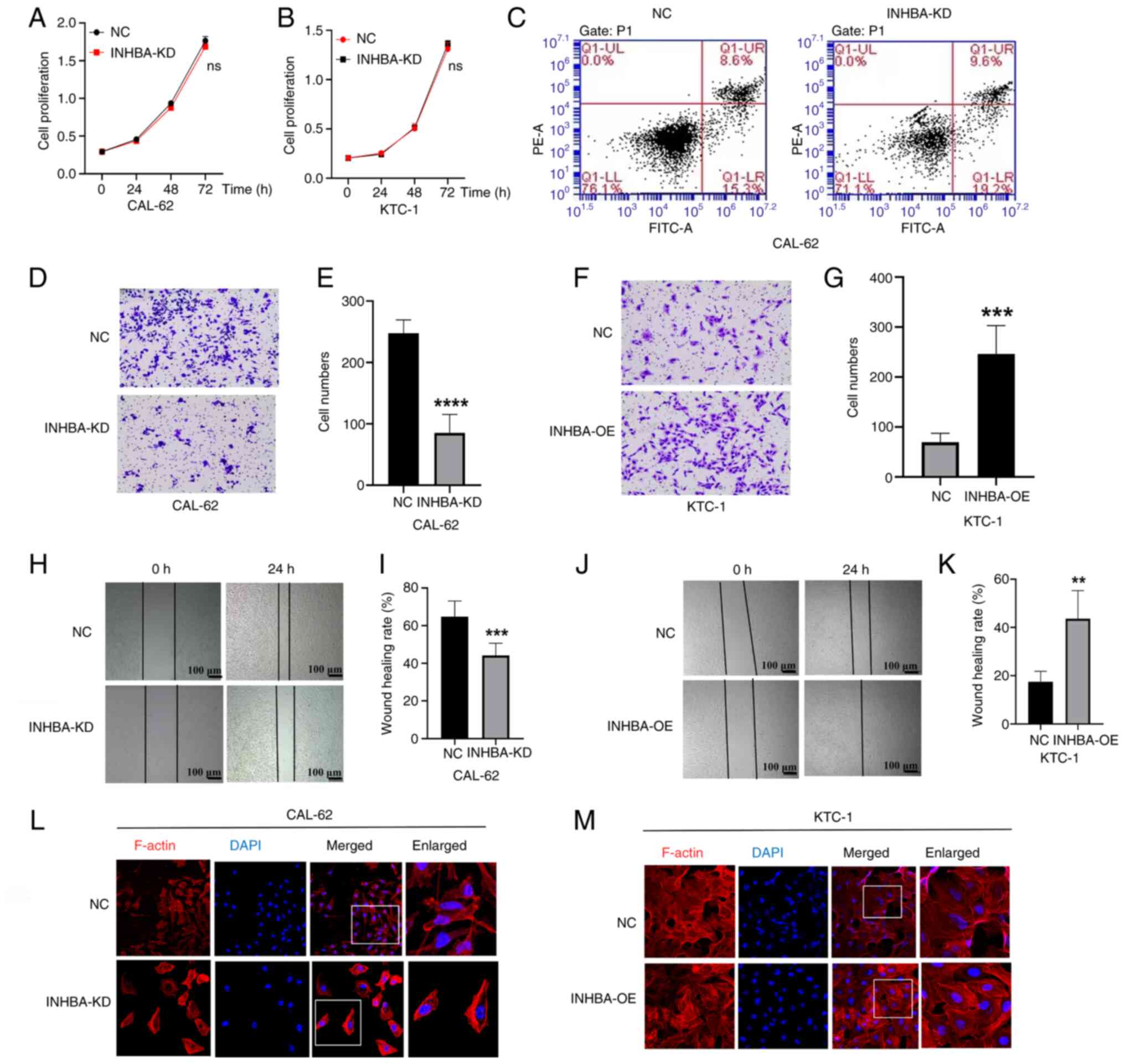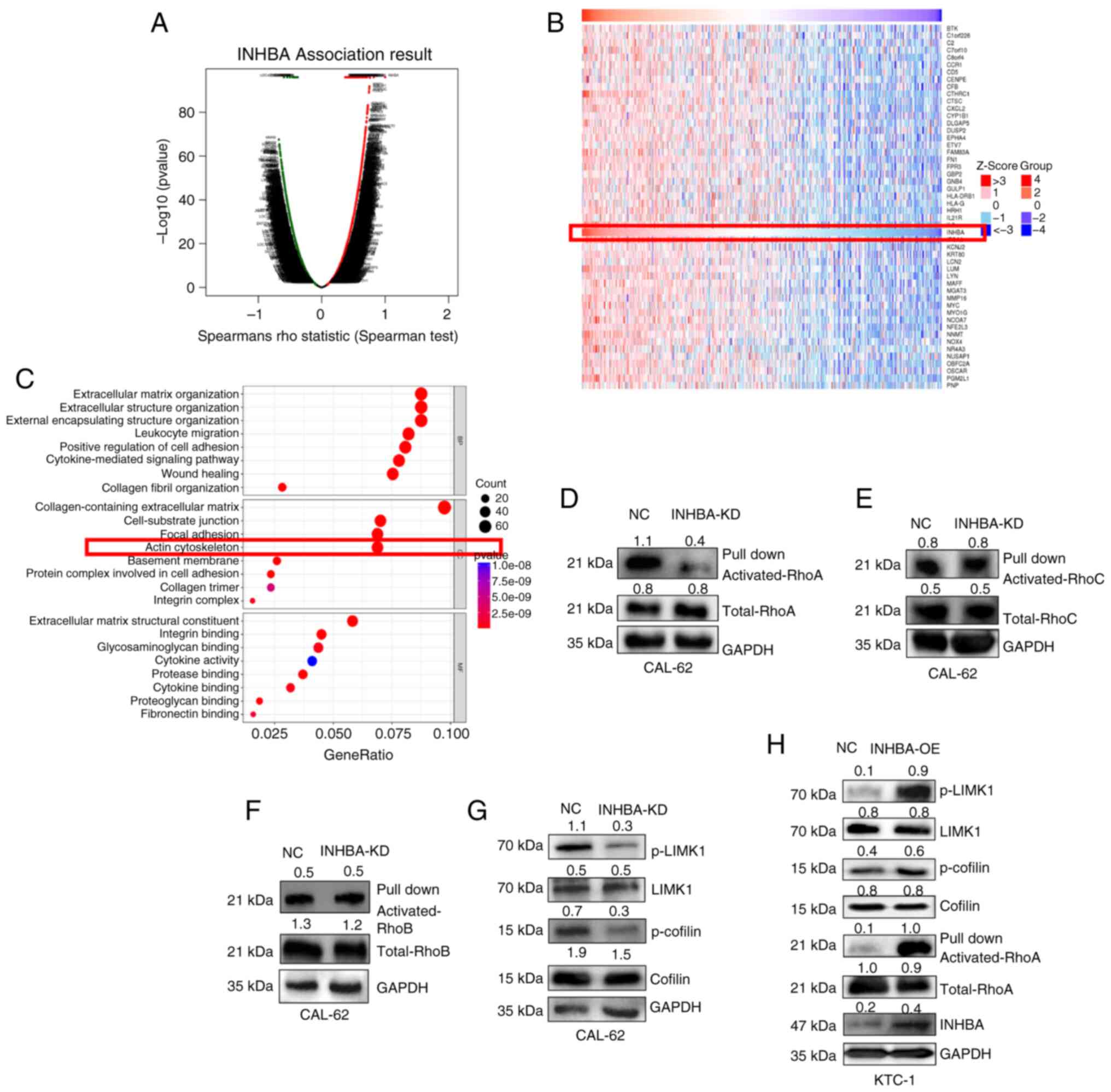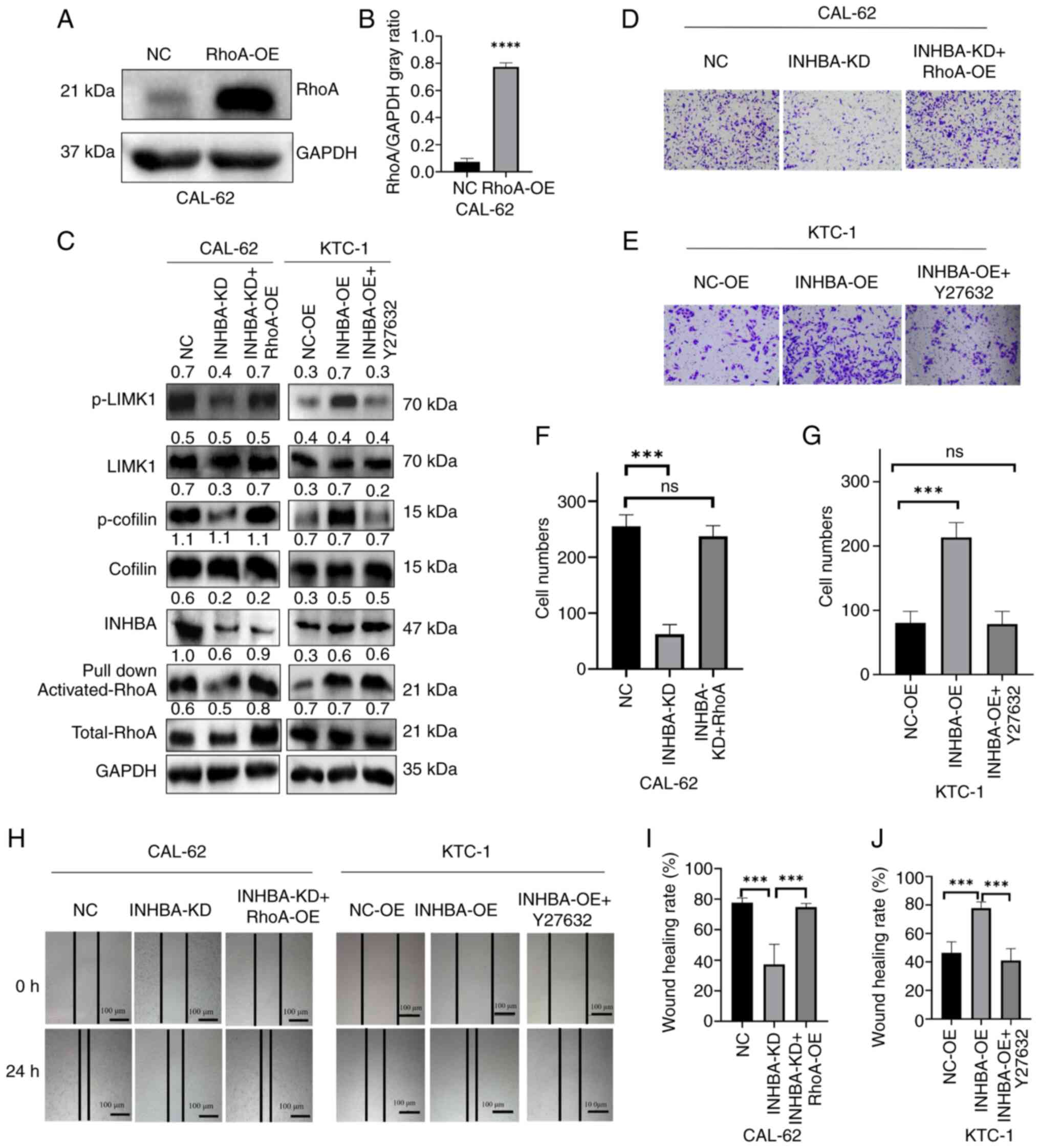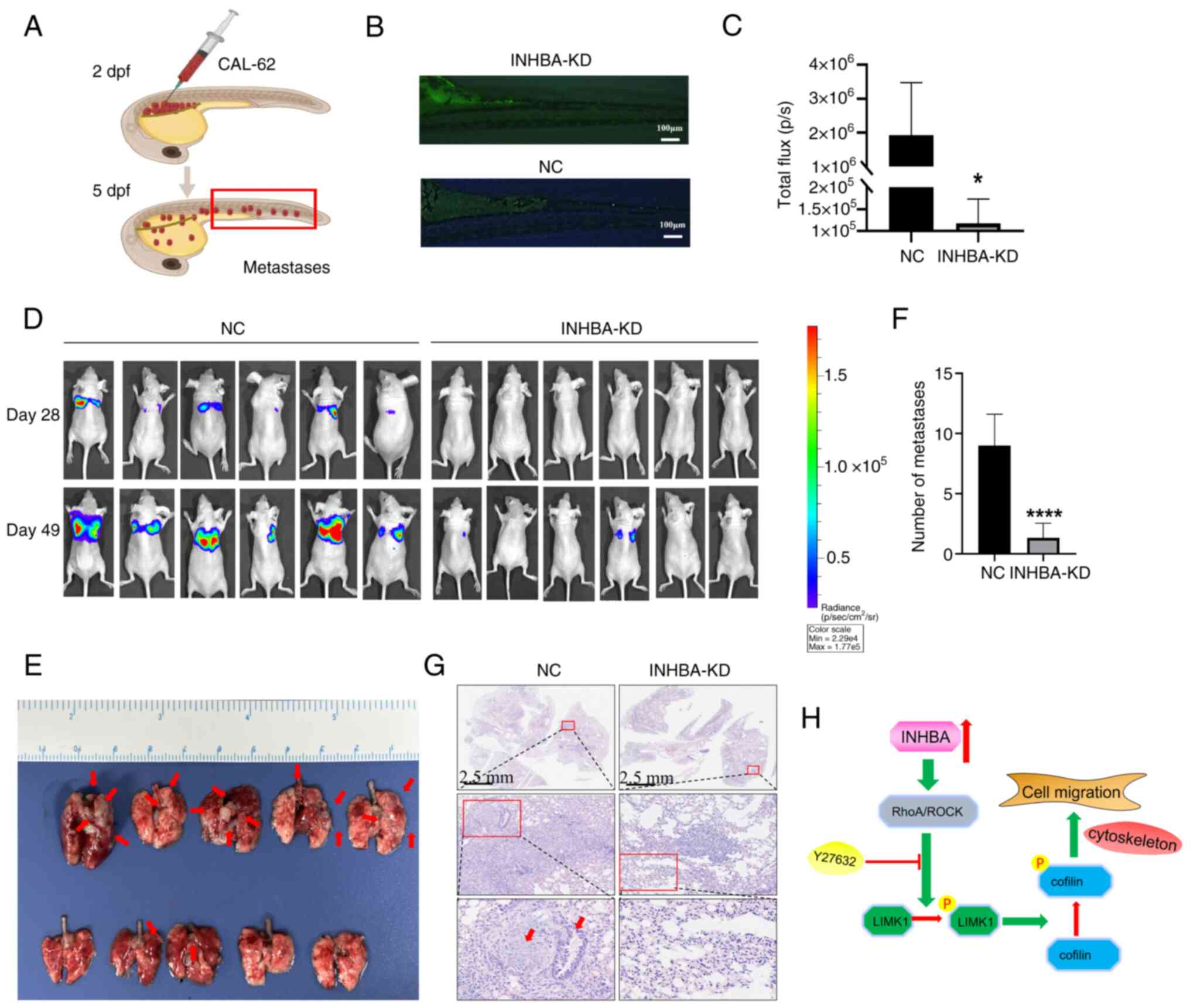|
1
|
Siegel RL, Miller KD, Wagle NS and Jemal
A: Cancer statistics, 2023. CA Cancer J Clin. 73:17–48. 2023.
View Article : Google Scholar : PubMed/NCBI
|
|
2
|
Pizzato M, Li M, Vignat J, Laversanne M,
Singh D, La Vecchia C and Vaccarella S: The epidemiological
landscape of thyroid cancer worldwide: GLOBOCAN estimates for
incidence and mortality rates in 2020. Lancet Diabetes Endocrinol.
10:264–272. 2022. View Article : Google Scholar : PubMed/NCBI
|
|
3
|
Araque DVP, Bleyer A and Brito JP: Thyroid
cancer in adolescents and young adults. Future Oncol. 13:1253–1261.
2017. View Article : Google Scholar : PubMed/NCBI
|
|
4
|
Miller KD, Fidler-Benaoudia M, Keegan TH,
Hipp HS, Jemal A and Siegel RL: Cancer statistics for adolescents
and young adults, 2020. CA Cancer J Clin. 70:443–459. 2020.
View Article : Google Scholar : PubMed/NCBI
|
|
5
|
American Cancer Society: Cancer facts
& figures 2024. Atlanta: American Cancer Society; 2024
|
|
6
|
Zheng R, Zhang S, Zeng H, Wang S, Sun K,
Chen R, Li L, Wei W and He J: Cancer incidence and mortality in
China, 2016. J Natl Cancer Cent. 2:1–9. 2022. View Article : Google Scholar : PubMed/NCBI
|
|
7
|
Molinaro E, Romei C, Biagini A, Sabini E,
Agate L, Mazzeo S, Materazzi G, Sellari-Franceschini S, Ribechini
A, Torregrossa L, et al: Anaplastic thyroid carcinoma: From
clinicopathology to genetics and advanced therapies. Nat Rev
Endocrinol. 13:644–660. 2017. View Article : Google Scholar : PubMed/NCBI
|
|
8
|
Durante C, Haddy N, Baudin E, Leboulleux
S, Hartl D, Travagli JP, Caillou B, Ricard M, Lumbroso JD, De
Vathaire F and Schlumberger M: Long-term outcome of 444 patients
with distant metastases from papillary and follicular thyroid
carcinoma: benefits and limits of radioiodine therapy. J Clin
Endocrinol Metab. 91:2892–2899. 2006. View Article : Google Scholar : PubMed/NCBI
|
|
9
|
Totsuka Y, Tabuchi M, Kojima I, Shibai H
and Ogata E: A novel action of activin A: Stimulation of insulin
secretion in rat pancreatic islets. Biochem Biophys Res Commun.
156:335–339. 1988. View Article : Google Scholar : PubMed/NCBI
|
|
10
|
Beattie GM, Lopez AD, Bucay N, Hinton A,
Firpo MT, King CC and Hayek A: Activin A maintains pluripotency of
human embryonic stem cells in the absence of feeder layers. Stem
Cells. 23:489–495. 2005. View Article : Google Scholar : PubMed/NCBI
|
|
11
|
Robson NC, Phillips DJ, McAlpine T, Shin
A, Svobodova S, Toy T, Pillay V, Kirkpatrick N, Zanker D, Wilson K,
et al: Activin-A: A novel dendritic cell-derived cytokine that
potently attenuates CD40 ligand-specific cytokine and chemokine
production. Blood. 111:2733–2743. 2008. View Article : Google Scholar
|
|
12
|
Kumar V, Ramnarayanan K, Sundar R,
Padmanabhan N, Srivastava S, Koiwa M, Yasuda T, Koh V, Huang KK,
Tay ST, et al: Single-cell atlas of lineage states, tumor
microenvironment, and subtype-specific expression programs in
gastric cancer. Cancer Discov. 12:670–691. 2022. View Article : Google Scholar
|
|
13
|
Zhang C, Liang Y, Ma MH, Wu KZ and Dai DQ:
KRT15, INHBA, MATN3, and AGT are aberrantly methylated and
differentially expressed in gastric cancer and associated with
prognosis. Pathol Res Pract. 215:893–899. 2019. View Article : Google Scholar : PubMed/NCBI
|
|
14
|
Lyu S, Jiang C, Xu R, Huang Y and Yan S:
INHBA upregulation correlates with poorer prognosis in patients
with esophageal squamous cell carcinoma. Cancer Manag Res.
10:1585–1596. 2018. View Article : Google Scholar : PubMed/NCBI
|
|
15
|
Li X, Yu W, Liang C, Xu Y, Zhang M, Ding X
and Cai X: INHBA is a prognostic predictor for patients with colon
adenocarcinoma. BMC Cancer. 20:3052020. View Article : Google Scholar : PubMed/NCBI
|
|
16
|
Shibata M, Inaishi T, Ichikawa T, Shimizu
D, Soeda I, Takano Y, Takeuchi D, Tsunoda N and Kikumori T:
Identifying the tumor-progressive gene expression profile in
high-risk papillary thyroid cancer. Surg Today. 51:1703–1712. 2021.
View Article : Google Scholar : PubMed/NCBI
|
|
17
|
Hall A: The cytoskeleton and cancer.
Cancer Metastasis Rev. 28:5–14. 2009. View Article : Google Scholar : PubMed/NCBI
|
|
18
|
Hohmann T and Dehghani F: The
cytoskeleton-A complex interacting meshwork. Cells. 8:3622019.
View Article : Google Scholar : PubMed/NCBI
|
|
19
|
Yamazaki D, Kurisu S and Takenawa T:
Regulation of cancer cell motility through actin reorganization.
Cancer Sci. 96:379–386. 2005. View Article : Google Scholar : PubMed/NCBI
|
|
20
|
Hodge RG and Ridley AJ: Regulating Rho
GTPases and their regulators. Nat Rev Mol Cell Biol. 17:496–510.
2016. View Article : Google Scholar : PubMed/NCBI
|
|
21
|
Loirand G: Rho kinases in health and
disease: From basic science to translational research. Pharmacol
Rev. 67:1074–1095. 2015. View Article : Google Scholar : PubMed/NCBI
|
|
22
|
Sahai E and Marshall CJ: RHO-GTPases and
cancer. Nat Rev Cancer. 2:133–142. 2002. View Article : Google Scholar
|
|
23
|
Tomás G, Tarabichi M, Gacquer D, Hébrant
A, Dom G, Dumont JE, Keutgen X, Fahey TJ III, Maenhaut C and
Detours V: A general method to derive robust organ-specific gene
expression-based differentiation indices: Application to thyroid
cancer diagnostic. Oncogene. 31:4490–4498. 2012. View Article : Google Scholar : PubMed/NCBI
|
|
24
|
Tarabichi M, Saiselet M, Trésallet C,
Hoang C, Larsimont D, Andry G, Maenhaut C and Detours V: Revisiting
the transcriptional analysis of primary tumours and associated
nodal metastases with enhanced biological and statistical controls:
Application to thyroid cancer. Br J Cancer. 112:1665–1674. 2015.
View Article : Google Scholar : PubMed/NCBI
|
|
25
|
Giordano TJ, Kuick R, Thomas DG, Misek DE,
Vinco M, Sanders D, Zhu Z, Ciampi R, Roh M, Shedden K, et al:
Molecular classification of papillary thyroid carcinoma: Distinct
BRAF, RAS, and RET/PTC mutation-specific gene expression profiles
discovered by DNA microarray analysis. Oncogene. 24:6646–6656.
2005. View Article : Google Scholar : PubMed/NCBI
|
|
26
|
Pernis AB, Ricker E, Weng CH, Rozo C and
Yi W: Rho Kinases in autoimmune diseases. Annu Rev Med. 67:355–374.
2016. View Article : Google Scholar : PubMed/NCBI
|
|
27
|
Wang L, Luo X, Cheng C, Amos CI, Cai G and
Xiao F: A gene expression-based immune signature for lung
adenocarcinoma prognosis. Cancer Immunol Immunother. 69:1881–1890.
2020. View Article : Google Scholar : PubMed/NCBI
|
|
28
|
Livak KJ and Schmittgen TD: Analysis of
relative gene expression data using real-time quantitative PCR and
the 2(-Delta Delta C(T)) method. Methods. 25:402–408. 2001.
View Article : Google Scholar
|
|
29
|
National Research Council (US): Committee
for the Update of the Guide for the Care and Use of Laboratory
Animals. The National Academies Collection: Reports funded by
National Institutes of Health. Guide for the Care and Use of
Laboratory Animals. 8th edition. National Academies Press;
Washington, DC: 2011
|
|
30
|
American Veterinary Medical Association:
AVMA Guidelines for the Euthanasia of Animals. 2020 edition.
American Veterinary Medical Association; Schaumburg, IL: 2020
|
|
31
|
Seetharaman S and Etienne-Manneville S:
Cytoskeletal crosstalk in cell migration. Trends Cell Biol.
30:720–735. 2020. View Article : Google Scholar : PubMed/NCBI
|
|
32
|
Yamaguchi H and Condeelis J: Regulation of
the actin cytoskeleton in cancer cell migration and invasion.
Biochim Biophys Acta. 1773:642–652. 2007. View Article : Google Scholar
|
|
33
|
Arnold TR, Stephenson RE and Miller AL:
Rho GTPases and actomyosin: Partners in regulating epithelial
cell-cell junction structure and function. Exp Cell Res. 358:20–30.
2017. View Article : Google Scholar : PubMed/NCBI
|
|
34
|
Song S, Cong W, Zhou S, Shi Y, Dai W,
Zhang H, Wang X, He B and Zhang Q: Small GTPases: Structure,
biological function and its interaction with nanoparticles. Asian J
Pharm Sci. 14:30–39. 2019. View Article : Google Scholar
|
|
35
|
Strassheim D, Gerasimovskaya E, Irwin D,
Dempsey EC, Stenmark K and Karoor V: RhoGTPase in vascular disease.
Cells. 8:5512019. View Article : Google Scholar : PubMed/NCBI
|
|
36
|
Wang Y, Tu Z, Zhao W, Wang L, Jiang J, Gu
L, Li M, Jiang L, Wang Y and Bi Y: PLCB1 enhances cell migration
and invasion in gastric cancer via regulating actin cytoskeletal
remodeling and epithelial-mesenchymal transition. Biochem Genet.
61:2618–2632. 2023. View Article : Google Scholar : PubMed/NCBI
|
|
37
|
Mu G, Ding Q, Li H, Zhang L, Zhang L, He
K, Wu L, Deng Y, Yang D, Wu L, et al: Gastrin stimulates pancreatic
cancer cell directional migration by activating the
Gα12/13-RhoA-ROCK signaling pathway. Exp Mol Med. 50:1–14. 2018.
View Article : Google Scholar : PubMed/NCBI
|
|
38
|
Wei X, Lou H, Zhou D, Jia Y, Li H, Huang
Q, Ma J, Yang Z, Sun C, Meng Y, et al: TAGLN mediated
stiffness-regulated ovarian cancer progression via RhoA/ROCK
pathway. J Exp Clin Cancer Res. 40:2922021. View Article : Google Scholar : PubMed/NCBI
|
|
39
|
Brose MS, Nutting CM, Jarzab B, Elisei R,
Siena S, Bastholt L, de la Fouchardiere C, Pacini F, Paschke R,
Shong YK, et al: Sorafenib in radioactive iodine-refractory,
locally advanced or metastatic differentiated thyroid cancer: A
randomised, double-blind, phase 3 trial. Lancet. 384:319–328. 2014.
View Article : Google Scholar : PubMed/NCBI
|
|
40
|
Schlumberger M, Tahara M, Wirth LJ,
Robinson B, Brose MS, Elisei R, Habra MA, Newbold K, Shah MH, Hoff
AO, et al: Lenvatinib versus placebo in radioiodine-refractory
thyroid cancer. N Engl J Med. 372:621–630. 2015. View Article : Google Scholar : PubMed/NCBI
|
|
41
|
Subbiah V, Kreitman RJ, Wainberg ZA, Cho
JY, Schellens JHM, Soria JC, Wen PY, Zielinski C, Cabanillas ME,
Urbanowitz G, et al: Dabrafenib and trametinib treatment in
patients with locally advanced or metastatic BRAF V600-mutant
anaplastic thyroid cancer. J Clin Oncol. 36:7–13. 2018. View Article : Google Scholar
|
|
42
|
Guo J and Liu Y: INHBA promotes the
proliferation, migration and invasion of colon cancer cells through
the upregulation of VCAN. J Int Med Res. 49:30006052110149982021.
View Article : Google Scholar : PubMed/NCBI
|
|
43
|
Yu SY, Luan Y, Tang S, Abazarikia A, Dong
R, Caffrey TC, Hollingsworth MA, Oupicky D and Kim SY: Uncovering
tumor-promoting roles of activin A in pancreatic ductal
adenocarcinoma. Adv Sci (Weinh). 10:e22070102023. View Article : Google Scholar : PubMed/NCBI
|
|
44
|
Kao CC, Chang YL, Liu HY, Wu ST, Meng E,
Cha TL, Sun GH, Yu DS and Luo HL: DNA hypomethylation is associated
with the overexpression of INHBA in upper tract urothelial
carcinoma. Int J Mol Sci. 23:20722022. View Article : Google Scholar : PubMed/NCBI
|
|
45
|
Wu Z, Chen J, Yang L, Sun K, Jiang Q, Dong
F, Lu W, Chen R and Chen Y: Elevated INHBA promotes tumor
progression of cervical cancer. Technol Cancer Res Treat.
23:153303382412347982024. View Article : Google Scholar : PubMed/NCBI
|
|
46
|
Hu C, Ye M, Bai J, Liu P, Lu F, Chen J, Xu
Y, Yan L, Yu P, Xiao Z, et al: FOXA2-initiated transcriptional
activation of INHBA induced by methylmalonic acid promotes
pancreatic neuroendocrine neoplasm progression. Cell Mol Life Sci.
81:502024. View Article : Google Scholar : PubMed/NCBI
|
|
47
|
Tang Y, He Y, Zhang P, Wang J, Fan C, Yang
L, Xiong F, Zhang S, Gong Z, Nie S, et al: LncRNAs regulate the
cytoskeleton and related Rho/ROCK signaling in cancer metastasis.
Mol Cancer. 17:772018. View Article : Google Scholar : PubMed/NCBI
|
|
48
|
Vilchez Mercedes SA, Bocci F, Levine H,
Onuchic JN, Jolly MK and Wong PK: Decoding leader cells in
collective cancer invasion. Nat Rev Cancer. 21:592–604. 2021.
View Article : Google Scholar : PubMed/NCBI
|
|
49
|
Gao J and Nakamura F: Actin-associated
proteins and small molecules targeting the actin cytoskeleton. Int
J Mol Sci. 23:21182022. View Article : Google Scholar : PubMed/NCBI
|
|
50
|
Fife CM, McCarroll JA and Kavallaris M:
Movers and shakers: Cell cytoskeleton in cancer metastasis. Br J
Pharmacol. 171:5507–5523. 2014. View Article : Google Scholar : PubMed/NCBI
|
|
51
|
Jones MC, Zha J and Humphries MJ:
Connections between the cell cycle, cell adhesion and the
cytoskeleton. Philos Trans R Soc Lond B Biol Sci. 374:201802272019.
View Article : Google Scholar : PubMed/NCBI
|
|
52
|
Burridge K and Wennerberg K: Rho and Rac
take center stage. Cell. 116:167–179. 2004. View Article : Google Scholar : PubMed/NCBI
|
|
53
|
Amano M, Nakayama M and Kaibuchi K:
Rho-kinase/ROCK: A key regulator of the cytoskeleton and cell
polarity. Cytoskeleton (Hoboken). 67:545–554. 2010. View Article : Google Scholar : PubMed/NCBI
|
|
54
|
Li X and Wang J: Mechanical tumor
microenvironment and transduction: Cytoskeleton mediates cancer
cell invasion and metastasis. Int J Biol Sci. 16:2014–2028. 2020.
View Article : Google Scholar : PubMed/NCBI
|
|
55
|
Tuntithavornwat S, Shea DJ, Wong BS,
Guardia T, Lee SJ, Yankaskas CL, Zheng L,
Kontrogianni-Konstantopoulos A and Konstantopoulos K: Giant
obscurin regulates migration and metastasis via RhoA-dependent
cytoskeletal remodeling in pancreatic cancer. Cancer Lett.
526:155–167. 2022. View Article : Google Scholar :
|
|
56
|
Etienne-Manneville S and Hall A: Rho
GTPases in cell biology. Nature. 420:629–635. 2002. View Article : Google Scholar : PubMed/NCBI
|
|
57
|
You T, Gao W, Wei J, Jin X, Zhao Z, Wang C
and Li Y: Overexpression of LIMK1 promotes tumor growth and
metastasis in gastric cancer. Biomed Pharmacother. 69:96–101. 2015.
View Article : Google Scholar : PubMed/NCBI
|
|
58
|
Chen J, Ananthanarayanan B, Springer KS,
Wolf KJ, Sheyman SM, Tran VD and Kumar S: Suppression of LIM kinase
1 and LIM kinase 2 limits glioblastoma invasion. Cancer Res.
80:69–78. 2020. View Article : Google Scholar :
|
|
59
|
Maekawa M, Ishizaki T, Boku S, Watanabe N,
Fujita A, Iwamatsu A, Obinata T, Ohashi K, Mizuno K and Narumiya S:
Signaling from Rho to the actin cytoskeleton through protein
kinases ROCK and LIM-kinase. Science. 285:895–898. 1999. View Article : Google Scholar : PubMed/NCBI
|
|
60
|
Lee MH, Kundu JK, Chae JI and Shim JH:
Targeting ROCK/LIMK/cofilin signaling pathway in cancer. Arch Pharm
Res. 42:481–491. 2019. View Article : Google Scholar : PubMed/NCBI
|
|
61
|
de Sousa GR, Vieira GM, das Chagas PF,
Pezuk JA and Brassesco MS: Should we keep rocking? Portraits from
targeting Rho kinases in cancer. Pharmacol Res. 160:1050932020.
View Article : Google Scholar : PubMed/NCBI
|
|
62
|
Yang L, Hou Y, Du YE, Li Q, Zhou F, Li Y,
Zeng H, Jin T, Wan X, Guan S, et al: Mirtronic miR-4646-5p promotes
gastric cancer metastasis by regulating ABHD16A and metabolite
lysophosphatidylserines. Cell Death Differ. 28:2708–2727. 2021.
View Article : Google Scholar : PubMed/NCBI
|
|
63
|
Fu L, Wang X, Yang Y, Chen M, Kuerban A,
Liu H, Dong Y, Cai Q, Ma M and Wu X: Septin11 promotes
hepatocellular carcinoma cell motility by activating RhoA to
regulate cytoskeleton and cell adhesion. Cell Death Dis.
14:2802023. View Article : Google Scholar : PubMed/NCBI
|



